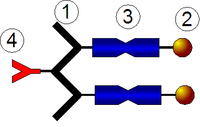
Photo from wikipedia
Abstract Lipase from Candida rugosa (CRL) was immobilized via adsorption on niobium pentoxide. The best condition for adsorption was pH 6, 150 rpm and enzyme/support ratio of 8000 U gsupport −1.… Click to show full abstract
Abstract Lipase from Candida rugosa (CRL) was immobilized via adsorption on niobium pentoxide. The best condition for adsorption was pH 6, 150 rpm and enzyme/support ratio of 8000 U gsupport −1. The kinetic study resulted in a better fit for pseudo-first order kinetics, and Langmuir isotherm best fit the data. Adsorption thermodynamics showed that the adsorption was favorable, and it approached to physical adsorption. After immobilization process, the optimum pH and the affinity of the biocatalyst for the substrate decreased, and the optimum temperature increased. Niobium pentoxide immobilized derivative (IDNb) presented suitable thermal stability, preserving more than 50% of its residual activity after 60 min of incubation at 60 °C. After 60 days of storage at 4 °C, the recorded loss of activity for IDNb was 45%.
Journal Title: Biocatalysis and agricultural biotechnology
Year Published: 2020
Link to full text (if available)
Share on Social Media: Sign Up to like & get
recommendations!